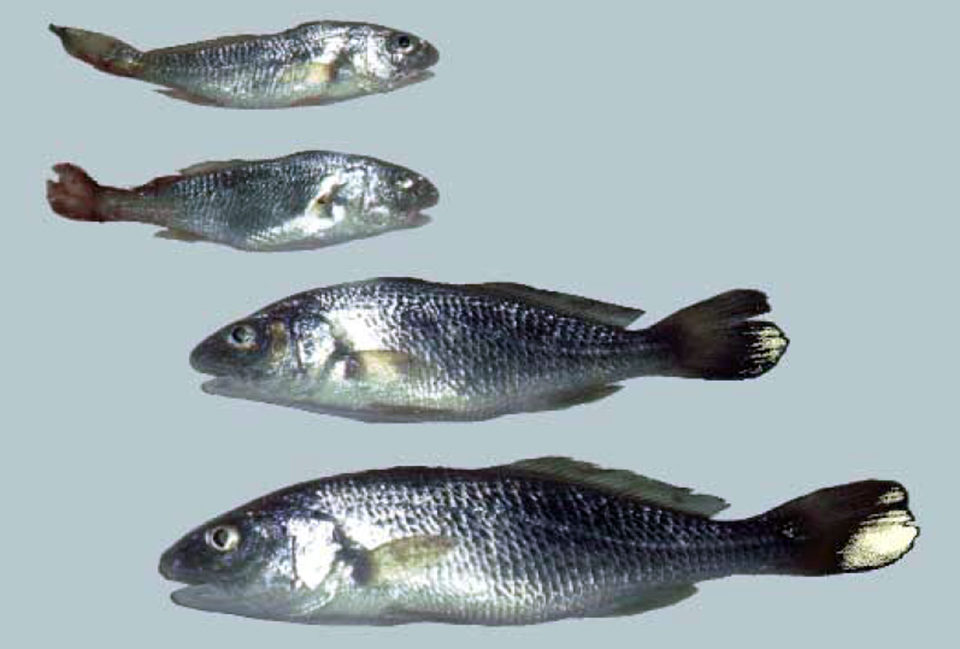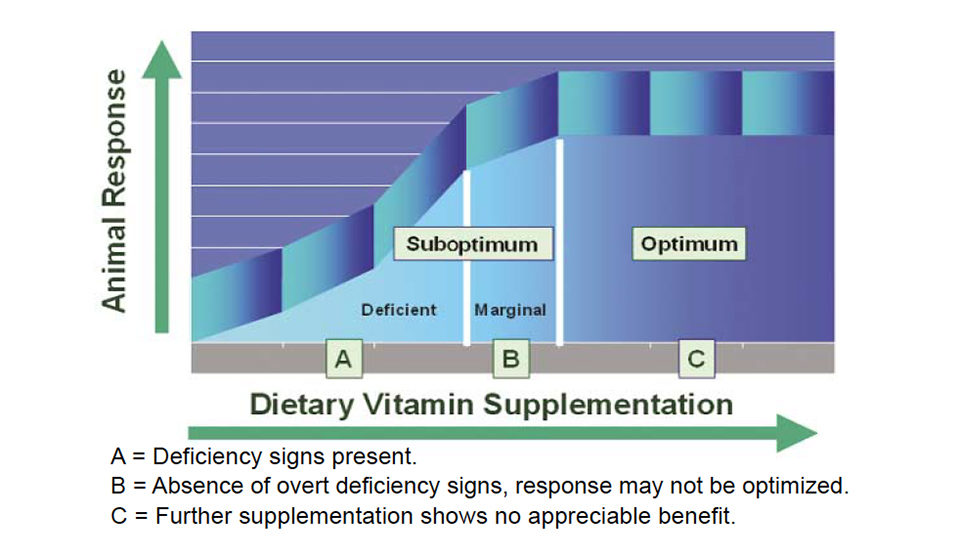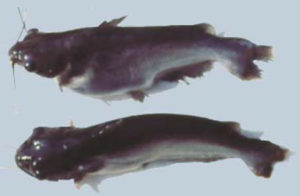There is a tendency to err on the side of overfortification

Vitamins are required in trace amounts from exogenous sources (usually the diet) for the normal growth, reproduction, and health of fish. Research on the interaction of vitamins and fish health has historically focused on estimating the minimum amount of these nutrients necessary to maintain normal growth, survival, and an absence of deficiency signs for a few economically important species. (Fig 1).

Common vitamin deficiency signs in fish include poor growth, reduced feed efficiency, hemorrhages, myopathies, increased coagulation time, hyperexcitability, cataracts, fin erosion, anemia, gill hyperplasia, and scoliosis. Minimum requirements for at least 15 vitamins have been established for fish utilizing these criteria, although considerable variation exists in the vitamin requirements of various species.
Most species require the fat-soluble group: vitamins A, D, E and K, and the water-soluble group: thiamin, riboflavin, B6 (pyridoxine), pantothenic acid, niacin, biotin, folate, B12 (cyanocobalamin), choline, myoinostitol and vitamin C.
Expanding literature
The body of literature regarding vitamin requirements for aquatic animals continues to expand. Requirements for numerous threatened and endangered species are being determined, in addition to those for an ever-expanding group of production aquaculture candidates.
Often, determination of the essential nature of vitamins for these species was undertaken following initial observations of deficiency signs. However, in the absence of defined nutrient requirements for new species, there is a tendency to err on the side of overfortification with vitamins.
Oversupplementation of vitamins in fish feeds was originally necessary to ensure adequate levels of labile vitamins following processing and storage. However, even with the advent of more-stable vitamin forms in the last two decades, the practice of supplementing diets at greater than requirement levels has continued because most vitamins can be administered at megadose levels without toxic effects. Also, the cost of vitamin supplementation is minimal when compared to the risk of production losses associated with deficiencies.
Fish health
Another reason for the continued supplementation of aquatic animal feeds at high levels is the growing body of research data that supports the roles of vitamins in fish health and disease resistance. Numerous studies have demonstrated a link between deficient levels of vitamins and impaired immune responses and disease resistance. In contrast, although some studies demonstrate a positive effect on fish health of vitamin supplementation above requirement levels, others show no benefit.
Possible reasons for the range of observed responses include varied rearing conditions, individual immune responses to evaluated pathogens, the large variations between species, genetic variation between fish, and the lack of “normal” ranges for the utilized response parameters in “healthy” fish.
Ultimately however, varied responses can most directly be attributed to experimental design deficiencies. Such deficiencies generally demonstrate a lack of understanding or oversimplification of the roles of vitamins in cell function and how animals’ quantitative needs for some vitamins change due to diet composition, life stage, and regulation of various physiological processes.
Dietary interactions
Diet composition can greatly impact the quantitative needs for some vitamins due to interactions between vitamins and other dietary macronutrients and micronutrients, or other dietary components (including antinutritional factors) that affect vitamin availability.
Examples of interactions between vitamins and dietary macro-nutrients include the increase of vitamin requirements in proportion to dietary energy content, the dependence of vitamin E needs on the type and quantity of dietary lipids (fatty acids), and the increased need for vitamin B6 with increases in dietary protein. Some of the most notable interactions between vitamins include the increased need for folic acid when ascorbic acid levels are low, the vitamin E-sparing effect of increased vitamin C levels, and the vitamin B12-sparing effect of elevated folate levels. Studies have also demonstrated substantial variability of the vitamin levels in many feed ingredients, as well as decreased absorption of vitamins from plant feedstuffs.
Unfortunately, these types of dietary interactions are often not factored into evaluations of the effects of vitamin supplementation on fish health, due in part to a lack of information regarding the endogenous levels and availability of various vitamins in most feedstuffs and an incomplete characterization of the diets utilized for studies. In fact, in most vitamin requirement studies, diets are formulated to contain excess levels of all essential nutrients, except the one under study. This approach can result in an underestimation of the target requirement, as it ignores potential interactions that affect the minimum required level.
Influence of life stage

Life stage also influences the need for vitamins in fish. It is generally accepted that the requirements for most vitamins decrease with age or size. As most vitamin studies for aquatic animals have been conducted with rapidly growing juveniles, this has contributed to the overfortification of commercial aquaculture diets. This has important implications, given the fact that over 90 percent of the feed used in production is consumed during the postjuvenile grow-out stage.
Recent studies with postjuvenile fish have demonstrated that vitamin supplementation can be substantially reduced or even eliminated for some species, such as channel catfish, resulting in lower diet costs without reducing growth. However, caution should be used prior to reducing or eliminating vitamins from grow-out diets of other species in the absence of supporting data.
Additionally, during maturation, fish likely require greater dietary vitamin levels than those required for normal growth. For example, in gilthead sea bream, elevated vitamin E levels reduce the percentage of abnormal eggs and increase fecundity. In salmonids, requirements for vitamin C are higher for broodstock than juveniles.
Cell functions
The roles of vitamins in various cell functions are diverse and currently only partially characterized. However, it is generally accepted that with increases in physiological processes such as inflammation, stress, and immune response, most tissue vitamin levels are rapidly depleted. This observation has led to the hypothesis that dietary levels greater than those required for growth are necessary to prevent tissue-specific vitamin deficiencies.
Vitamin deficiency is known to negatively affect wound healing and increase susceptibility to infection and stress. Therefore, vitamin requirement levels that fluctuate with animals’ condition have important implications in designing diets that optimize fish health. Conditionally fluctuating vitamin requirements may also explain why although substantial research correlates the effects of vitamin deficiency with the suppression of immune cell functions in fish, research demonstrating the beneficial effects of supplementation on immune cell function is less clear.
The considerable variation in published reports on the ability of vitamins to improve disease resistance and survival following infection with various pathogens is not surprising. A better understanding of the mechanisms through which vitamins influence cell functions and immune systems is necessary to appreciate the many complex interactions between diet and susceptibility to infectious diseases.
Recent advances in analytical methodologies – including microarray analysis, which can globally characterize the mechanisms through which vitamins modulate immune function and screen for a wider variety of functional changes – in metabolite and protein profiles coupled with standardized protocols offer new approaches to identify the modes of action and potential interactions of vitamins in future fish health research.
(Editor’s Note: This article was originally published in the June 2005 print edition of the Global Aquaculture Advocate.)
Now that you've finished reading the article ...
… we hope you’ll consider supporting our mission to document the evolution of the global aquaculture industry and share our vast network of contributors’ expansive knowledge every week.
By becoming a Global Seafood Alliance member, you’re ensuring that all of the pre-competitive work we do through member benefits, resources and events can continue. Individual membership costs just $50 a year. GSA individual and corporate members receive complimentary access to a series of GOAL virtual events beginning in April. Join now.
Not a GSA member? Join us.
Authors
-
Wendy M. Sealey, Ph.D.
Hagerman Fish Culture Experiment Station
University of Idaho
3059F National Fish Hatchery Road
Hagerman, Idaho 83332 USA -
Ronald W. Hardy, Ph.D.
Hagerman Fish Culture Experiment Station
University of Idaho
3059F National Fish Hatchery Road
Hagerman, Idaho 83332 USA
Tagged With
Related Posts

Intelligence
A brief look at genetically modified salmon
If approved by FDA, fast-growing genetically modified salmon will provide a safe and nutritious product similar to other farmed Atlantic salmon.

Health & Welfare
A holistic management approach to EMS
Early Mortality Syndrome has devastated farmed shrimp in Asia and Latin America. With better understanding of the pathogen and the development and improvement of novel strategies, shrimp farmers are now able to better manage the disease.

Aquafeeds
A look at India’s fish feed industry
India's fish-farming industry makes limited use of modern feeds, providing potential for the feed sector to grow. Commercial feeds are predominantly used for pangasius farming, followed by a rising popularity in carp culture.

Aquafeeds
A new nutrient for aquaculture, from microbes that consume carbon waste
Biotechnology firm NovoNutrients aims to produce a line of nutraceutical aquafeed additives as well as a bulk feed ingredient that can supplement fishmeal. Its process includes feeding carbon dioxide from industrial gas to a “microbial consortium” starring hydrogen-oxidizing bacteria.


